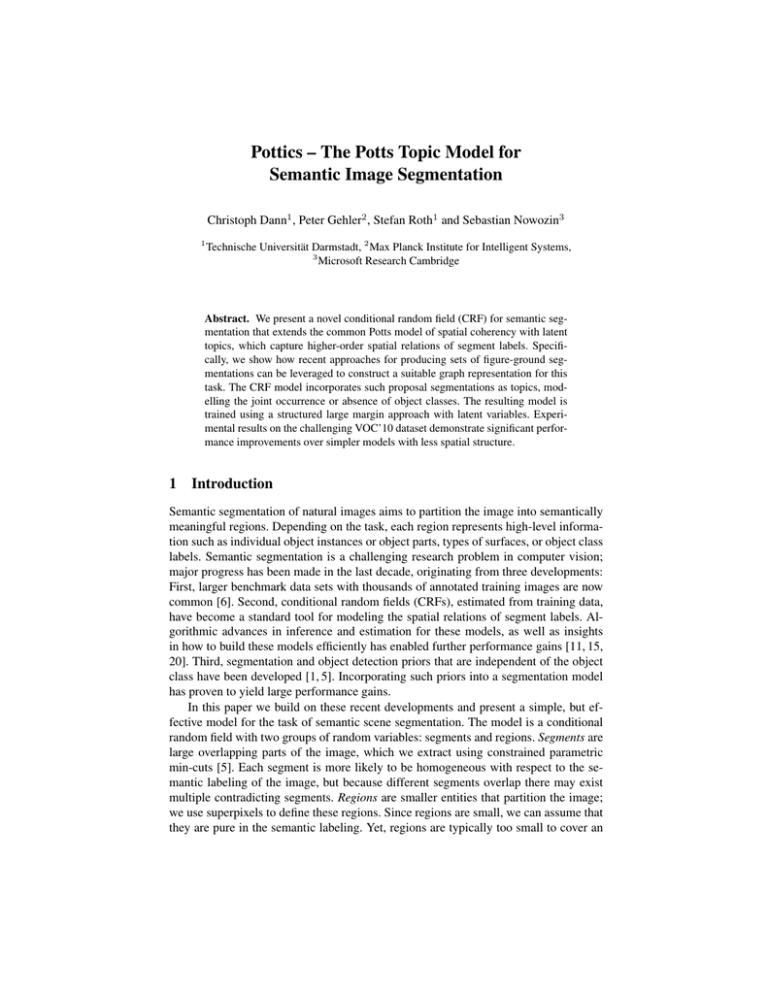Pottics – The Potts Topic Model for Semantic
advertisement

Pottics – The Potts Topic Model for
Semantic Image Segmentation
Christoph Dann1 , Peter Gehler2 , Stefan Roth1 and Sebastian Nowozin3
1
Technische Universität Darmstadt, 2 Max Planck Institute for Intelligent Systems,
3
Microsoft Research Cambridge
Abstract. We present a novel conditional random field (CRF) for semantic segmentation that extends the common Potts model of spatial coherency with latent
topics, which capture higher-order spatial relations of segment labels. Specifically, we show how recent approaches for producing sets of figure-ground segmentations can be leveraged to construct a suitable graph representation for this
task. The CRF model incorporates such proposal segmentations as topics, modelling the joint occurrence or absence of object classes. The resulting model is
trained using a structured large margin approach with latent variables. Experimental results on the challenging VOC’10 dataset demonstrate significant performance improvements over simpler models with less spatial structure.
1
Introduction
Semantic segmentation of natural images aims to partition the image into semantically
meaningful regions. Depending on the task, each region represents high-level information such as individual object instances or object parts, types of surfaces, or object class
labels. Semantic segmentation is a challenging research problem in computer vision;
major progress has been made in the last decade, originating from three developments:
First, larger benchmark data sets with thousands of annotated training images are now
common [6]. Second, conditional random fields (CRFs), estimated from training data,
have become a standard tool for modeling the spatial relations of segment labels. Algorithmic advances in inference and estimation for these models, as well as insights
in how to build these models efficiently has enabled further performance gains [11, 15,
20]. Third, segmentation and object detection priors that are independent of the object
class have been developed [1, 5]. Incorporating such priors into a segmentation model
has proven to yield large performance gains.
In this paper we build on these recent developments and present a simple, but effective model for the task of semantic scene segmentation. The model is a conditional
random field with two groups of random variables: segments and regions. Segments are
large overlapping parts of the image, which we extract using constrained parametric
min-cuts [5]. Each segment is more likely to be homogeneous with respect to the semantic labeling of the image, but because different segments overlap there may exist
multiple contradicting segments. Regions are smaller entities that partition the image;
we use superpixels to define these regions. Since regions are small, we can assume that
they are pure in the semantic labeling. Yet, regions are typically too small to cover an
2
C. Dann, P. Gehler, S. Roth, S. Nowozin
entire semantic instance such as an object. Therefore they provide only limited evidence for a semantic class. Regions and segments represent two complementary levels
of groupings of image pixels. This is illustrated in Fig. 1.
Our CRF model combines the two primitives into one coherent semantic segmentation model. To that end, segments represent latent topics and regions represent the
actual consistent image labeling. The two components are coupled by an interaction
term that associates semantic labels of regions with latent segment-level topics. The
topics thus describe how region labels are spatially arranged. By learning the interaction terms from training data we jointly discover latent topics and their relation to the
region-level class label.
Our contributions are the following: (1) A novel semantic segmentation model that
integrates latent segment-level topics with a consistent image labeling, and (2) an efficient latent structural SVM training method for the model. Experiments on the challenging PASCAL VOC 2010 challenge demonstrate significant accuracy gains over various
baselines, including Potts-based label smoothing.
2
Related Work
Our approach integrates a segmentation prior into a random field model. This follows
a range of previous work, which has remained limited in various ways. Superpixel segmentations [17], small coherent regions in the image that are likely to belong a single
object class, build the foundation of several recent semantic labeling approaches. It is
a standard practise to define a structured model, such as a CRF, on top of superpixel
segmentations [2, 16, 13, 8, 7], because the superpixels provide computational benefits
and regularization. These previous approaches differ in the way they incorporate spatial
consistency between superpixels.
Flat CRF models, such as [16, 7, 2], are formulated on class assignments of superpixels and penalize different labels of neighbors by a pairwise smoothing term. In case
of [2], the spatial relation is estimated from training data. [7] additionally considers
image features on superpixels and their direct neighbors. These features are then classified, leading to spatially robust decisions. All these methods use a flat neighborhood
relation to formulate spatial consistency.
Hierarchical CRFs in contrast, promote spatial label consistency using higher-level
entities to couple pixel classes. [14] uses a tree-structured CRF on iteratively refined
superpixels that allows efficient parameter learning. Recent extensions [8, 13] augment
this hierarchical CRF with higher-order potentials to incorporate image-level information and promote smoothness among many pixels.
Another class of methods [3, 16] first performs an intelligent oversegmentation of
the image into likely objects, and then processes the “segment soup” to find objects.
By combining the found objects, a single segmentation of the input is produced. The
approach of [3] performs very well but is algorithmic, therefore has no explicit model
that can be estimated from data. In [16] a manually tuned CRF is used to fuse multiple oversegmentations. Multiple attempts keep the flavour (and performance) of [3]
while providing a principled probabilistic model have been made recently. In [4] and
its extensions [9, 10], a pairwise graph is constructed by adding an edge between each
overlapping pair of segments. By solving a maximal clique problem on the graph a coherent segmentation of the image is obtained. While principled, the approach is limited,
Pottics – The Potts Topic Model for Semantic Image Segmentation
R1
S1
S2
S3
R2
R3
R4
3
R5
Fig. 1. CRF factor graph structure: CPMC segments (top row) represent latent topics, the regions
from the corresponding decomposition of the image (bottom row) yield the semantic labels. A
region is connected to a segment if it is fully contained in it; image evidence enters through
unaries. Simplified example with 3 segments and 5 regions.
because it only considers pairwise terms between segments; in contrast our approach
uses latent variables that can act on all regions within a segment.
3
Pottics Model
Our proposed CRF for semantic segmentation builds on three main components: (i)
Segmentation proposals from [3], which yield the regions via a superpixelization of
the input image as well as the graph structure; (ii) the CRF model itself including the
potentials, which model bottom-up image evidence and the segment-region relations;
and (iii) structured max-margin training with latent variables for the learning part [21].
For learning we assume that we are given a set of N training images I i , i = 1, . . . , N
along with ground truth pixel-wise class labelings Y i , i = 1, . . . , N . We now describe
the model components in turn.
3.1
CPMC segmentation proposals
We build upon the Constrained-Parametric-Min-Cuts (CPMC) method [5] that generates a set of plausible figure-ground segmentations. The main idea behind this algorithm
for the use of semantic segmentation is to pre-generate a number of plausible segmentations, from which, in a separate step, a segment is chosen as the final prediction. This
largely reduces the state space and also reduces the problem of semantic segmentation to a ranking problem, which allows efficient ranking algorithms to be used. This
method consistently performed with top scores on the PASCAL VOC segmentation
challenges [6].
The complete CPMC algorithm is rather involved; we can thus only present a brief
summary and refer to [5] for details. CPMC operates in three steps to generate a set
of binary foreground-background segmentations. First a graph-cut problem is solved
multiple times with different pixels in the images being forced to become foreground.
Figure 2 (top row, 3rd from left) illustrates this: By forcing different pixels (green) to be
foreground and solving the graph-cut problem, CPMC produces different binary segmentation masks. Parts of the image borders may be chosen as foreground in order to
4
C. Dann, P. Gehler, S. Roth, S. Nowozin
Fig. 2. Top row (left to right): Input image, ground truth annotation, example of seeds used for
min-cut, top-four segments with their score. Bottom row (left to right): segments 5–10, resulting
region segmentation from pairwise intersection of segments.
allow for partially occluded objects. This first step generates a large number of plausible segmentation hypotheses, but many of these segmentations are almost identical. The
second step of the CPMC algorithm filters the set of segments based on a score computed from their overlap. In addition, segments that are deemed too small are removed.
On average, about 300–400 segmentation masks per image are retained after this filtering procedure. In the third and last step, the segments are scored in order to predict how
“object-like” they are. To this end 34 different features derived from segment shape,
gestalt, and graph properties are used. For illustration, we show the ten highest scored
segments for an example image in Fig. 2.
For every input image we generate a set of segments Si , i = 1, . . . , NS using the
CPMC procedure. From these segments we compute the set of all their intersections.
We refer to these as the regions Ri , i = 1, . . . , NR of the image. By construction all the
regions are disjoint, Ri ∩ Rj = ∅, ∀i, j. For the running example in Fig. 2 the output
of this step is depicted on the bottom right. Here, the image is partitioned into 1550
different regions.
3.2 CRF formulation
We use the multiple segmentations from CPMC to construct a random field model as
follows (see Fig. 1 for an example): Assume that the image has been segmented into NR
regions and NS segments, where the values NR , NS can vary from image to image. In
order to maintain a simple notation we will ignore this. Each region i can take values in
Ri ∈ {1, . . . , C}, where C denotes the number of semantic classes. The segments j are
modeled as taking values in Sj ∈ {1, . . . , T }, where T is the number of latent topics, to
be determined by model selection. With bold letters we will refer to the concatenation of
variables, i.e. R = (R1 , . . . , RNR ). We connect all regions with the segments they are
contained in and place a pairwise potential function on them. Furthermore we connect
the region variables with image evidence by using unary potentials. The full CRF joint
probability is now given as p(R, S) ∝ exp(−E(R, S)) with
NR
NR X
X
X
E(R, S) = −hw, φ(R, S, I)i = −
hwu , φu (Ri , I)i −
hwp , φp (Ri , Sj , I)i.
i=1
i=1 j∼i
(1)
Pottics – The Potts Topic Model for Semantic Image Segmentation
5
We use j ∼ i to denote that region i is contained in segment j, that is, whether the
variables Ri and Sj share a common edge in the graph. We make a simple choice for
the pairwise features, namely φp (R, S) being a binary vector of size C ·T , with a 1 at the
entry that corresponds to (R, S) and 0 otherwise. This allows the parameters wp to be
represented a vector of size C · T . For the unary features we use standard, pre-computed
image descriptors; more details are given in Sec. 4.
3.3 Learning
The undirected bi-partite graph structure of the model renders computation of the normalization function intractable. Therefore, maximum likelihood learning of the model
is intractable as well, and one would have to resort to approximate versions or different
estimators, such as contrastive divergence or the pseudo-likelihood. We here follow a
different route and use a max-margin approach.
Specifically, we learn the parameters of the CRF in Eq. (1) using a structured SVM
with latent variables [21]. The optimization problem can be written as
1
(2)
min kwk2 + Cξ
w,ξ 2
X
sb.t.
max max hw, φ(R̄, S̄, I i )i + ∆(R̄, Y i ) − max hw, φ(Ri , S, I i )i ≤ ξ
i
R̄
S
S̄
This non-convex problem is solved with the cutting plane algorithm as implemented in
the latentSVMstruct software package.1 With ∆ : Y × Y → R we denote the loss
+
function that measures the quality of our prediction.
In order to optimize Eq. (2), the following loss-augmented inference problem needs
to be solved:
h
i
R̄ = argmax maxhw, φ(R̃, S, I)i + ∆(R̃, Y ) .
R̃
S
(3)
To make a prediction on a novel test image, we need to solve the energy minimization
problem
R∗ = argmax maxhw, φ(R, S, I)i.
R
S
(4)
Different loss functions ∆ have been used for semantic scene segmentation. The
authors of the PASCAL VOC challenge [6] implement the following criterion to cope
with the unbalanced number of pixels per class
∆(Ȳ , Y ) =
C
1 X |Yk ∪ Ȳk |
.
C
|Yk ∩ Ȳk |
k=1
(5)
With Yk we denote the binary segmentation mask with 1’s where Y is of class k, 0
otherwise. However, this loss is hard to incorporate during training because it does not
decompose over individual regions due to the normalizing denominator. In other words,
optimally predicting segmentations for one test image alone is not possible, and all test
images need to be predicted jointly. In [19] this issue is addressed by recognizing it to be
a problem of inference with a higher order potential. An exact inference algorithm that
empirically scales with N log N is given. We take an easier approach and circumvent
1
http://www.cs.cornell.edu/people/tj/svm light/svm struct.html
6
C. Dann, P. Gehler, S. Roth, S. Nowozin
this problem by substituting the loss function during training time with the Hamming
loss as a proxy
|Y |
1 X
[Y (i) 6= Ȳ (i)],
(6)
∆H (Ȳ , Y ) =
|Y | i=1
where [·] denotes the Iverson bracket and Y (i) the ith pixel of the segmentation Y . This
renders Eq. (3) to be decomposable per image, and furthermore even per region in the
image. The loss-augmented inference for image-label pair (I, Y ) then reduces to
argmax max
R̄
S
NR
NR X
NR
X
X
X
∆H (R̄i , Y ). (7)
hwp , φp (R̄i , Sj , I)i+
hwu , φu (R̄i , I)i+
i=1
i=1 j∼i
i=1
Hence the loss can be seen as just another unary factor applied to the regions.
To approximately solve the inference problems in Eqs. (4) and (7), we apply Iterated Conditional Modes (ICM). With fixed region variables, we update the segment
variables, then for fixed segment variables we update the region variables. Since the
graph is bi-partite all regions and segments can be updated in parallel. Convergence is
typically reached in about 3 iterations per image.
4
Experiments
We test our model2 on the very challenging PASCAL VOC 2010 semantic segmentation
dataset. Since the test set is not publicly available, we train on the train split while
testing using the val split (964 images each).
The main objective of this work is to utilize proposal segmentations and CRFs to
improve over unary or region-wise prediction methods. Therefore, we use a single,
competitive unary [12] from the literature as a baseline, which has been pre-trained
on the training portion of VOC’10 and is publicly available3 . The unary potentials are
based on TextonBoost [18] augmented by color, pixel location, histogram of gradients
(HOG) information, as well as the outputs of bounding box object detectors. While
unary feature functions can be learned jointly with the pairwise components, this is not
the main motivation here. Since, moreover, piecewise training has been shown to be a
competitive speed-up (e.g. [14]) we fix the pre-trained unaries as our unary feature φu
and train only a scaling factor wu as well as the pairwise potentials.
4.1 Baseline methods
We test against various baseline methods: First, we use the unary potential function to
predict pixel class membership directly (UO). Next, pixel-predictions are accumulated
over regions and all pixels within a region are assigned to the maximal class score
(RP). A third method makes use of the CPMC segments. To that end, all segments
accumulate the pixel-predictions of the unary factor and the highest scoring class is
chosen as the “segment-label”. Since a pixel may be contained in multiple segments,
its class is predicted to be the majority vote of all segment labels of segments that it is
contained in. We call this method segment-prediction (SP).
2
3
Part of the code used in our experiments is available at http://github.com/chrodan/pottics
http://graphics.stanford.edu/projects/densecrf/unary/
Pottics – The Potts Topic Model for Semantic Image Segmentation
7
Besides these simple voting strategies, we evaluate the classic Potts model as another baseline. That is we connect all neighboring regions (in the sense of a pixel being
in a 4-connected neighbourhood relationship with another region) with a pairwise factor of the simple form φp (Ri , Rj ) = α[Ri = Rj ]. We choose α by model selection, but
found that any value α 6= 0 deteriorates the performance. We still include this method
(Potts) with α = 0.5. Last, we consider our model with the number of topics T being
set to 1 as a generalized form of the Potts model that makes use of the special graph
structure that we are building. This model (1T) is also trained using the max-margin
learning. All methods use the same set of NS = 100 segments and the resulting region
decomposition. We found that fewer segments cannot represent details in images well
enough and additional segments deteriorate performance because of their low quality.
4.2
Empirical results
The empirical results are summarized in Table 1. We report both accuracy using the
Hamming loss (left, Eq. (6)) and the VOC loss (right, Eq. (5)). Here the Pottics model
has been trained with the number of topics set to T = 50 (we tested with setting
T ∈ {25, 100} and found qualitatively the same results). We make the following observations: The Pottics model outperforms the other baselines on most classes, and in the
class-averaged total score. This confirms our intuition that the CPMC segments provide
valuable information on how to connect different regions in the image. We also note that
turning this additional information into better performance is not immediate. All other
baseline methods that use the constructed graph (SP, Potts, 1T) perform worse than the
simple UO baseline. Against our intuition, Potts performs worse as well. We suspect
that the unary pixel prediction is sufficiently strong to already incorporate neighbourhood information, hence a simple class smoothing performs worse.
The gain of Pottics over UO is quite substantial with an 5.2% increase in average VOC performance. In Fig. 3 we show images where the improvement in terms
of accuracy using the Hamming loss is highest, and in Fig. 4 example images where
performance drops compared to UO.
We note that other approaches obtain higher absolute scores (e.g. [12]), but they are
computationally more involved and also include elaborate feature tuning and stacking.
We restrict ourselves to a simple, efficient base method to show the desired effects, but
expect similar improvements when the Pottics model is used in combination with more
advanced approaches.
Training of the Pottics model takes about 3 hours with T = 50 on the 964 training
images. ICM typically converges in 3 iterations, which in our implementation requires
about 5 seconds per image. Most time is spent in generating the CPMC segments, about
5-10 minutes for a single image using the public implementation4 of the authors of [5].
4.3
Effect of segment topics
In Fig. 6 we show the learned parameters of the Pottics model when using T = 50 topics
per segment. High values correspond to less probable combinations, e.g. topic #15 has
low values for bus (class 6) and car (7), since those are likely to appear together, while
4
http://sminchisescu.ins.uni-bonn.de/code/cpmc/ [Version 1.0]
8
C. Dann, P. Gehler, S. Roth, S. Nowozin
Fig. 3. Example segmentations for which the Pottics model improves most. From left to right:
UO output, Pottics prediction, ground truth. In the second row, the monitor is almost perfectly
recovered. In the airplane example the Pottics model corrects the boat class (blue) to be an airplane.
Fig. 4. Example segmentations for which the performance deteriorates. Same ordering as in
Fig. 3. In the lower left, the person segment is wrongly joined with the horse segment. In the
lower right example, the table is mistaken for a chair.
Fig. 5. Two examples for the topic impact of tables. From left to right: UO prediction, Pottics prediction, ground truth. Classes person, table and bottle.
175
0
150
125
Classes
5
100
75
10
50
25
15
0
20
0
10
20
Topics
30
40
−25
Fig. 6. Learned parameters wp . The value of the unary parameter is wu = −156.6. High values
correspond to less probable combinations. The class ordering corresponds to the listing in Table 1.
Pottics – The Potts Topic Model for Semantic Image Segmentation
Hamm. %
background
plane
bicycle
bird
boat
bottle
bus
car
cat
chair
cow
table
dog
horse
motorbike
person
plant
sheep
sofa
train
tv
average
total
UO
96.1
29.2
0.7
14.4
17.0
16.2
36.4
47.0
49.6
6.7
11.5
6.5
16.0
19.4
33.6
48.3
11.5
24.8
14.9
33.1
26.5
26.6
79.2
RP
96.8
28.5
0.6
13.7
16.8
15.6
35.9
47.1
50.1
6.8
11.1
5.5
15.7
19.1
34.1
48.0
10.7
25.1
14.7
33.0
24.6
26.4
79.7
SP
97.1
13.0
0.0
2.5
4.9
2.3
31.3
40.6
43.3
0.3
2.2
1.0
8.0
3.9
24.2
41.4
9.0
10.4
6.0
20.4
8.2
17.6
77.6
Potts
95.0
26.0
0.6
12.4
15.7
12.8
36.3
47.9
50.2
6.4
9.0
5.3
14.7
16.2
32.2
50.4
10.5
21.6
13.9
31.1
22.2
25.3
78.2
1T Pottics
96.8 92.5
10.2 45.9
0.1
4.8
3.0 35.6
4.8 27.0
3.9 27.9
23.2 59.5
32.3 62.5
72.1 70.9
2.8
8.7
2.6 23.3
2.9 20.2
4.9 16.0
6.5 21.7
17.8 42.2
33.4 51.6
5.9 19.8
11.3 23.4
7.9 14.4
19.0 46.4
4.2 33.8
17.4 35.6
77.3 78.9
VOC %
background
plane
bicycle
bird
boat
bottle
bus
car
cat
chair
cow
table
dog
horse
motorbike
person
plant
sheep
sofa
train
tv
total
UO
80.3
27.6
0.6
11.9
16.0
15.2
33.0
43.3
28.8
5.2
10.7
5.4
12.2
16.1
28.4
34.6
11.0
20.0
12.8
30.1
23.2
22.2
RP
80.5
27.4
0.6
11.9
16.1
14.9
33.1
44.2
30.4
5.5
10.5
4.7
12.3
16.3
29.4
35.7
10.3
20.9
12.9
30.3
22.0
22.4
SP
77.5
12.8
0.0
2.3
4.8
2.3
29.0
37.3
25.4
3.4
2.2
1.0
7.3
3.7
20.9
33.2
8.4
9.9
5.7
19.1
8.0
14.8
Potts
78.8
22.4
0.6
10.7
13.7
12.7
32.2
43.2
26.5
5.4
7.8
4.5
11.9
13.4
26.9
35.2
9.7
17.4
11.7
28.8
20.9
20.7
9
1T Pottics
78.7 80.8
10.1 41.0
0.1
3.9
2.8 22.1
4.8 25.3
3.8 24.2
22.4 41.3
31.4 52.8
25.0 25.3
2.5
6.4
2.5 20.2
2.7 12.5
4.5 11.5
6.1 18.6
16.5 34.7
28.4 37.1
5.7 16.2
10.8 21.0
7.4 12.3
18.2 39.9
4.2 27.6
13.8 27.4
Table 1. Performance on the VOC 2010 validation set: (left) accuracy using Hamming loss,
(right) VOC accuracy. The different methods are described in the text.
at the same time making joint occurrence with classes such as cat, table, dog, horsea
unlikely and thus down-weighting their score.
The class table is one that performs better under the Pottics model, with an increase
of 7.1% in VOC accuracy. In Fig. 5 we show two examples of this class. The topic #21
is dominant, its value having the effect of placing higher scores on the labels table. Most
probably this accounts for the effect of tables not being segmented well by the CPMC
algorithm, which the Pottics model can address. In the right example of Fig. 5 a table
segment emerges, since the topic has a positive effect on the two objects bottle and table
appearing jointly. The table is not present in the ground truth annotation though, hence
this example deteriorates performance.
5
Conclusion
We introduced a novel CRF model for semantic image segmentation that goes beyond
Potts-like spatial smoothing using latent topics. The model is inspired by the success of
methods that generate class-independent figure-ground proposal segmentations, which
are used to define the graph structure between regions to be labeled and segments,
which represent the latent topics. Training relied on a structured max-margin formulation with latent variables. We evaluated our model on the challenging VOC’10 dataset
and found it to significantly improve performance over non-spatial as well as simple
spatial baselines.
10
C. Dann, P. Gehler, S. Roth, S. Nowozin
This paper focused on showing the effect of incorporating segmentation information into the prediction. There are many different ways on how the proposed Pottics
model can be extended. First, the unary potential function of the regions could be jointly
trained with the entire model. The segment variables could further be made imagedependent and equipped with unary factors. While we find that both the Hamming and
VOC accuracy are positively correlated, prediction remains sub-optimal when the inference is done using the Hamming loss.
References
1. Alexe, B., Deselaers, T., Ferrari, V.: What is an object? In: CVPR (2010)
2. Batra, D., Sukthankar, R., Chen, T.: Learning class-specific affinities for image labelling. In:
CVPR (2008)
3. Carreira, J., Li, F., Sminchisescu, C.: Object Recognition by Sequential Figure-Ground
Ranking. IJCV August (2011)
4. Carreira, J., Ion, A., Sminchisescu, C.: Image segmentation by discounted cumulative ranking on maximal cliques. arXiv CoRR abs/1009.4823 (2010)
5. Carreira, J., Sminchisescu, C.: Constrained parametric min-cuts for automatic object segmentation. In: CVPR. pp. 3241–3248 (2010)
6. Everingham, M., Gool, L., Williams, C.K.I., Winn, J., Zisserman, A.: The Pascal Visual
Object Classes (VOC) Challenge. IJCV 88(2), 303–338 (Sep 2009)
7. Fulkerson, B., Vedaldi, A., Soatto, S.: Class segmentation and object localization with superpixel neighborhoods. In: ICCV (2009)
8. Gonfaus, J., Boix, X., van de Weijer, J., Bagdanov, A., Serrat, J., Gonzalez, J.: Harmony
potentials for joint classification and segmentation. In: CVPR (2010)
9. Ion, A., Carreira, J., Sminchisescu, C.: Image segmentation by figure-ground composition
into maximal cliques. In: ICCV (2011)
10. Ion, A., Carreira, J., Sminchisescu, C.: Probabilistic joint image segmentation and labeling.
In: NIPS (2011)
11. Kolmogorov, V.: Convergent tree-reweighted message passing for energy minimization.
PAMI 28(10), 1568–1583 (2006)
12. Krähenbühl, P., Koltun, V.: Efficient inference in fully connected crfs with gaussian edge
potentials. In: NIPS (2011)
13. Ladicky, L., Russell, C., Kohli, P., Torr, P.H.S.: Associative hierarchical CRFs for object
class image segmentation. In: ICCV. IEEE (Sep 2009)
14. Nowozin, S., Gehler, P., Lampert, C.: On parameter learning in CRF-based approaches to
object class image segmentation. In: ECCV. Springer (2010)
15. Nowozin, S., Lampert, C.: Structured Learning and Prediction in Computer Vision. Foundations and Trends in Computer Graphics and Vision 6(3-4), 185–365 (2011)
16. Pantofaru, C., Schmid, C.: Object recognition by integrating multiple image segmentations.
In: ECCV. Springer (2008)
17. Ren, X., Malik, J., Division, C.S.: Learning a classification model for segmentation. In: ICCV
(2003)
18. Shotton, J., Winn, J., Rother, C., Criminisi, A.: Textonboost for image understanding: Multiclass object recognition and segmentation by jointly modeling texture, layout, and context.
In: IJCV (2007)
19. Tarlow, D., Zemel, R.: Big and tall: Large margin learning with high order losses. In: CVPR
Ws. on Inference in Graphical Models with Structured Potentials (2011)
20. Vishwanathan, S.V.N., Schraudolph, N.N., Schmidt, M.W., Murphy, K.P.: Accelerated training of conditional random fields with stochastic gradient methods. In: ICML (2006)
21. Yu, C.N., Joachims, T.: Learning structural svms with latent variables. In: ICML (2009)







